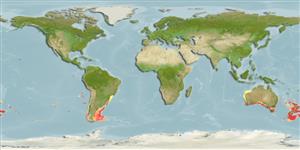Common names from other countries
>
Gadiformes (Cods) >
Macruronidae (Blue grenadiers)
Etymology: Macruronus: Greek, makros = great + Greek, onos = hake.
Environment: milieu / climate zone / depth range / distribution range
Sinh thái học
Biển; Thuộc về nước lợ Sống nổi và đáy; Ở đại duơng, biển; Mức độ sâu 0 - 1000 m (Ref. 26566), usually 200 - 700 m (Ref. 9563). Subtropical; 15°S - 55°S, 111°E - 173°W (Ref. 58452)
Southwest Pacific: New Zealand and southern Australia.
Length at first maturity / Bộ gần gũi / Khối lượng (Trọng lượng) / Age
Maturity: Lm 67.5, range 65 - 70 cm
Max length : 120 cm TL con đực/không giới tính; (Ref. 1371); 130.0 cm TL (female); common length : 80.0 cm TL con đực/không giới tính; (Ref. 1371); Khối lượng cực đại được công bố: 1.5 kg (Ref. 1371); Khối lượng cực đại được công bố: 1.5 kg; Tuổi cực đại được báo cáo: 25 các năm (Ref. 6390)
Các tia vây lưng cứng (tổng cộng): 12 - 13; Các vây lưng mềm (tổng cộng): 96-106; Tia cứng vây hậu môn 0; Tia mềm vây hậu môn: 89 - 93; Động vật có xương sống: 78 - 81. Dorsal surface silvery, with a purple or blue-green tinge; plank and belly silvery; fins darker. Body very elongate and compressed with a tapering tail, dorsal and anal fins confluent with the caudal fin (Ref. 33856).
Appear to live usually on or near the bottom, but may occasionally move up into mid-waters. Large adult fish generally occur deeper than 400 m, while juveniles may be found in shallower water (Ref. 9072), more commonly found in large estuaries and bays, and may even enter freshwaters (Ref. 1371). Juvenile specimens and especially adults belonging to the American subspecies, have been caught from the coastal zone to 110 m (Ref. 58452). Form schools. Feed primarily on lantern fishes. In New Zealand, it feeds in midwater on small fish, crustaceans and squid. Oviparous, spawn 1 million eggs on the average which are released all at one time (Ref. 6390). Utilized fresh and frozen; can be steamed, fried, cooked in microwave and baked (Ref. 9988).
Female blue grenadier produce about 1 million eggs on average, which are all released at once (Ref. 6390).
Cohen, D.M., T. Inada, T. Iwamoto and N. Scialabba, 1990. FAO species catalogue. Vol. 10. Gadiform fishes of the world (Order Gadiformes). An annotated and illustrated catalogue of cods, hakes, grenadiers and other gadiform fishes known to date. FAO Fish. Synop. 125(10). Rome: FAO. 442 p. (Ref. 1371)
IUCN Red List Status (Ref. 130435)
CITES (Ref. 128078)
Not Evaluated
Threat to humans
Harmless
Human uses
Can't connect to MySQL database (fbapp). Errorcode: Too many connections
